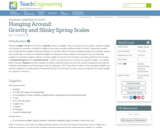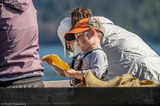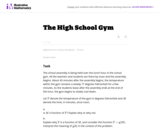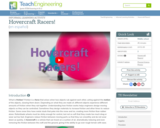
Students build spring scales and learn about the concept of weight.
- Subject:
- Science
- Material Type:
- Lesson
- Provider:
- TeachEngineering
- Provider Set:
- TeachEngineering
- Date Added:
- 10/14/2015

Students build spring scales and learn about the concept of weight.

This is a challenging task, suitable for extended work, and reaching into a deep understanding of units. The task requires students to exhibit MP1, Make sense of problems and persevere in solving them. An algebraic solution is possible but complicated; a numerical solution is both simpler and more sophisticated, requiring skilled use of units and quantitative reasoning. Thus the task aligns with either A-CED.1 or N-Q.1, depending on the approach.

The purpose of this activity is to demonstrate some of the different parts of an airplane through the construction of a paper airplane. Students will build several different kinds of paper airplanes in order to figure out what makes an airplane fly and what can be changed to influence the flying characteristics of an airplane.

Students' eyes are opened to the value of creative, expressive and succinct visual presentation of data, findings and concepts. Student pairs design, redesign and perform simple experiments to test the differences in thermal conductivity (heat flow) through different media (foil and thin steel). Then students create visual diagrams of their findings that can be understood by anyone with little background on the subject, applying their newly learned art vocabulary and concepts to clearly communicate their results. The principles of visual design include contrast, alignment, repetition and proximity; the elements of visual design include an awareness of the use of lines, color, texture, shape, size, value and space. If students already have data available from other experiments, have them jump right into the diagram creation and critique portions of the activity.

Through a teacher demonstration using water, heat and food coloring, students see how convection moves the energy of the Sun from its core outwards. Students learn about the three different modes of heat transfer (convection, conduction, radiation) and how they are related to the Sun and life on our planet.

Students learn the fundamental concepts of heat transfer and heat of reaction. This includes concepts such as physical chemistry, an equation for heat transfer, and a basic understanding of energy and heat transfer.

Students discover the scientific basis for the use of inclined planes. Using a spring scale, a bag of rocks and an inclined plane, student groups explore how dragging objects up a slope is easier than lifting them straight up into the air. Also, students are introduced to the scientific method and basic principles of experimentation. To conclude, students imagine and design their own uses for inclined planes.

Students learn about weight and drag forces by making paper helicopters and measuring how adding more weight affects the time it takes for the helicopters to fall to the ground.

Students gain a basic understanding of the engineering components behind telecommunications, in particular, the way telephone communication works to link one phone to another for conventional landline and cellular telephones. During this entire-class activity, students simulate how phone calls are connected by acting out a variety of searches for both local and long-distance calls. Students end up with a good understanding of how phone calls are transmitted from callers to recipients.

Media Description | 5 minutes We're diving for data! With the help of an “eye in the sky” and some savvy scuba surveyors, researchers are estimating the number of herring in the water... by counting their eggs! But modern methods can only tell us so much. To get the full picture, we turn to the people who know the herring best. If you like this content you can see all of the available resources in the Harvest module in the Ocean School Help Centre (https://help.oceanschool.nfb.ca/educational-resources/module-guides/the-harvest-module-guide). >> Activity Description | 5 minutes'Herring census' - Stock assessment survey: Students are challenged to determine which herring stock will most likely have a healthy population in the future! Students perform a herring census using a simplified version of the methods used by scientists at Fisheries and Oceans Canada. An additional data sheet is available with this activity: https://docs.google.com/spreadsheets/d/1BRhtQ3t1PEN3wHJwtZTuELdVH3hnC56jjCCXEFBw95I/template/preview

The goal of this task is to use geometry study the structure of beehives. Beehives have a tremendous simplicity as they are constructed entirely of small, equally sized walls. In order to as useful as possible for the hive, the goal should be to create the largest possible volume using the least amount of materials. In other words, the ratio of the volume of each cell to its surface area needs to be maximized. This then reduces to maximizing the ratio of the surface area of the cell shape to its perimeter.

While not a full-blown modeling problem, this task does address some aspects of modeling as described in Standard for Mathematical Practice 4. Also, students often think that time must always be the independent variable, and so may need some help understanding that one chooses the independent and dependent variable based on the way one wants to view a situation.

In this task students must interpret a function in relation to a given problem.

The purpose of this task is to assess understanding of how study design dictates whether a conclusion of causation is warranted. This study was observational and not an experiment, which means that it is not possible to reach a cause-and-effect conclusion.

Students review the what they have learned throughout the five lessons in this unit. This includes a review of many types of engineers, reminding students of the various everyday products, structures and processes they design and create in our world.

Students further their understanding of the engineering design process while combining mechanical engineering and bioengineering to create an automated medical device. During the activity, students are given a fictional client statement and are required to follow the steps of the design process to create medical devices that help reduce the workload for hospital workers and increase the quality of patient care.

Students apply the concepts of conduction, convection and radiation as they work in teams to solve two challenges. One problem requires that they maintain the warm temperature of one soda can filled with water at approximately human body temperature, and the other problem is to cause an identical soda can of warm water to cool as much as possible during the same 30-minute time period. Students design their engineering solutions using only common everyday materials, and test their devices by recording the water temperatures in their two soda cans every five minutes.

Students gain first-hand experience on how friction affects motion. They build a hovercraft using air from a balloon to levitate a craft made from a compact disc (CD), learning that a bed of air under an object significantly reduces the friction as it slides over a surface.

Students learn about friction and its effects on motion by building model hovercrafts.

This task is designed as an assessment item. It requires students to use information in a two-way table to calculate a probability and a conditional probability. Although the item is written in multiple choice format, the answer choices could be omitted to create a short-answer task.